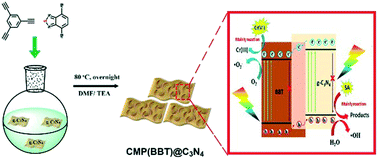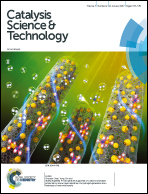Highly efficient visible light induced photocatalytic activity of a novel in situ synthesized conjugated microporous poly(benzothiadiazole)–C3N4 composite†
Abstract
In this study, a novel π-conjugated microporous poly(benzothiadiazole)–graphitic carbon nitride (BBT–C3N4) photocatalyst was synthesized through a facile in situ palladium-catalyzed Sonogashira–Hagihara cross-coupling polycondensation of 4,7-dibromobenzo[c][1,2,5]thiadiazole with 1,3,5-triethynylbenzene in the presence of evenly dispersed g-C3N4 using mixed DMF/TEA as solvent at 80 °C. Systematic characterization results revealed that BBT was equally dispersed on the surface of C3N4 with chemical bonds. The photocatalytic tests showed that this BBT–C3N4 composite exhibited enhanced photocatalytic removal of both sulfathiazole and Cr(VI) in comparison with the pure BBT and C3N4 as well as a mechanical mixture of BBT and C3N4, indicating that the oxidation and reduction abilities of BBT–C3N4 were simultaneously enhanced after composition under visible light irradiation. This was subsequently confirmed by radical detection, PL analysis and scavenger experiments as well. Holes and photoelectrons were demonstrated to be the main active species during the photocatalytic removal of sulfathiazole and Cr(VI), respectively. A possible photoelectron transfer mechanism for efficient photoinduced electron–hole separation of BBT–C3N4 composites is proposed based on all the results. This study provides new insight into the design of highly efficient visible light-driven photocatalysts with superior redox ability for wastewater treatment.



 Please wait while we load your content...
Please wait while we load your content...